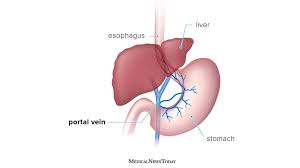Portal hypertension occurs when the blood pressure in the portal vein exceeds 10 millimeters of mercury (mm Hg). People with a high risk for liver disease and cirrhosis also have an increased risk for portal hypertension. According to the National Institute of Diabetes and Digestive and Kidney Diseases, people over the age of 50 are more likely to develop cirrhosis, and it is more common in males than in females. ortal hypertension is difficult to diagnose from a person’s symptoms alone. However, a doctor may suspect that a person has portal hypertension if their medical history and current health status suggest that they have a high risk for cirrhosis. There are several treatment options for portal hypertension. People may require a combination of medication, lifestyle changes, and surgical interventions. Treating the underlying causes of portal hypertension may help prevent further liver damage. People who have severe liver damage or liver cancer may require a liver transplant. Without treatment, portal hypertension can lead to severe complications, such as chronic bleeding, abdominal swelling, and liver failure. Doctors typically treat portal hypertension with a combination of blood pressure-lowering medication, lifestyle changes, and surgery (Credits: www.medicalnewstoday.com)


